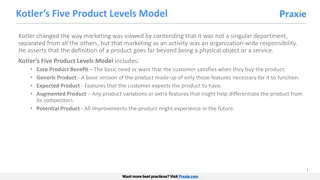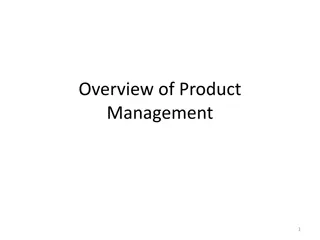
BI Trends Are Enhancing Product Lifecycle Management, and It’s About Smarter Decisions
Explore how cutting-edge Business Intelligence trends are revolutionizing Product Lifecycle Management (PLM), enabling more informed and strategic decision-making. This blog delves into the transformative integration of BI into PLM processes, highlig
Download Presentation

Please find below an Image/Link to download the presentation.
The content on the website is provided AS IS for your information and personal use only. It may not be sold, licensed, or shared on other websites without obtaining consent from the author. Download presentation by click this link. If you encounter any issues during the download, it is possible that the publisher has removed the file from their server.
E N D
Presentation Transcript
BI Trends Are Enhancing Product Lifecycle Management, and It s About Smarter Decisions With an increasingly hyper-connected market landscape, the fusion of Business Intelligence (BI) with Product Lifecycle Management (PLM) is catalyzing a paradigm shift towards more insightful, data-driven decision-making processes. This symbiotic integration is not just an enhancement; it's a complete re-envisioning of how products are conceived, developed, and refined. With Business Intelligence trends continually evolving, the methodologies and strategies of PLM are experiencing unprecedented advancements, empowering businesses to not only respond to market demands with agility but also anticipate them with unprecedented precision. In this exploration, we delve into the core aspects of how modern Business Intelligence trends are augmenting PLM frameworks, facilitating a transformative journey from traditional guesswork to intelligence-driven strategies. This narrative will unveil how leveraging the right BI tools like those offered by Grow can lead to smarter decisions that significantly amplify product success and sustainability in the marketplace. Join us as we uncover the potent impact of BI on PLM and illustrate the critical role it plays in sculpting the future of manufacturing and product management. What s PLM? Product Lifecycle Management (PLM) is a strategic approach focused on managing a product's lifecycle from inception through design and manufacture, to service and disposal. Companies and their extended organizations use PLM to combine people, data, processes, and business systems for product information. The primary goal of PLM is to increase product efficiencies and reduce costs by improving how products are designed, built, and supported. PLM systems help organizations cope with the increasing complexity and engineering challenges of developing new products for the global competitive markets.
The Evolution of Business Intelligence (BI) and Its Impact on PLM Business Intelligence has transformed significantly from simple data reporting to advanced predictive analytics. Initially, BI tools provided basic insights and past performance data, but today, they incorporate machine learning, AI, and big data technologies, offering deeper insights into operations, customer behavior, and market trends. The evolution of BI impacts PLM by providing a deeper understanding of each phase of the product lifecycle. Business Intelligence solutions now enable quicker decision-making based on analytics, forecast product success, and identify potential market failures before they occur. Current Business Intelligence Trends Revolutionizing PLM: 1. Data Integration Across Platforms
Our increasingly complex business environment states that data integration across multiple platforms is crucial for comprehensive PLM. Business Intelligence tools, such as Grow, play an important role by enabling the seamless integration of disparate data sources with over 100 data connectors. This integration enhances visibility across the entire product lifecycle from initial design through end-of-life management. By consolidating data from various sources like ERP systems, customer feedback tools, and supply chain management software, BI solutions provide a unified view that is essential for accurate and holistic decision-making. Key Benefits: Unified Data Repository: Centralizes data, reducing inconsistencies and improving data quality. Enhanced Collaboration: Facilitates better communication and coordination across departments, crucial for successful PLM. Accelerated Time-to-Market: Streamlines processes by providing quicker access to needed information, reducing delays in product development and launch phases. 2. Predictive Analytics and Machine Learning Predictive analytics, powered by machine learning algorithms, is transforming how Business Intelligence software companies forecast product performance and adapt to market trends. These Business Intelligence solutions use historical data and predictive models to anticipate future outcomes with significant accuracy. In PLM, applying predictive analytics means being able to predict product failures, understand customer needs, and tailor products to market demands proactively. Key Benefits:
Forecast Accuracy: Improves the precision of product success predictions, enhancing strategic planning. Proactive Decision Making: Allows companies to anticipate market changes and customer preferences, rather than merely reacting to them. Risk Reduction: Identifies potential issues before they become costly problems, enhancing overall product quality and compliance. 3. Real-time Data Access and Analysis The ability to access and analyze data in real-time is another trend reshaping PLM. Real-time Business Intelligence tools provide immediate insights into every stage of the product lifecycle, from development through phase-out. This capability is crucial for making timely decisions that can significantly impact the success and profitability of products. Real-time data analysis helps in managing inventories, responding to customer feedback instantly, and adapting to market changes swiftly. Key Benefits: Enhanced Agility: Empowers businesses to quickly adapt strategies based on current data, staying ahead of market curves. Improved Customer Satisfaction: Allows for immediate responses to customer feedback and market shifts, which can enhance user experience and product reception. Streamlined Operations: Reduces downtime and inefficiencies by providing instant insights into operational bottlenecks or disruptions. 4. Customizable Dashboards for Strategic Insights Customizable dashboards are a critical feature of advanced Business Intelligence software, offering tailored insights that improvement. These dashboards allow stakeholders to visualize critical data points and metrics relevant to their specific roles and needs. By enabling users to configure and focus on key performance indicators (KPIs) related to different lifecycle stages, these dashboards facilitate better-informed strategic decisions. drive product innovation and process Key Benefits: Targeted Insights: Provides relevant information tailored to the needs of different departments, enhancing specific processes and decisions. Increased Productivity: Reduces time spent on data mining and analysis, allowing teams to focus more on strategic tasks.
Data-Driven Innovation: Encourages continual improvement and innovation based on data trends and performance metrics observed through the dashboard. How BI Tools Foster Smarter Decision-Making in Product Lifecycle Management (PLM) Business Intelligence (BI) tools are at the forefront of revolutionizing PLM by providing the insights and analytics needed for smarter decision-making. 1. Enhanced Visibility Across Product Life Cycles BI tools integrate data from multiple sources across the enterprise, providing a comprehensive view of the entire product lifecycle. This integration allows managers and teams to see the big picture as well as minute details, ensuring that decisions are based on complete and accurate information. Real-Time Data Synthesis: BI tools like Grow aggregate real-time data from production, sales, customer feedback, up-to-the-minute insights that are critical for rapid decision-making. Holistic Overview: By breaking down silos and integrating data, Business Intelligence software companies ensure that stakeholders have a unified view, which is crucial for aligning decisions with overall business strategy. and supply chains, offering 2. Predictive Analytics for Proactive Management Predictive analytics, a key Business Intelligence trend, uses algorithms and machine learning to forecast future trends based on historical data. In PLM, this capability enables companies to anticipate market demands, potential production issues, and customer preferences before they fully emerge. Forecasting Product Success: BI tools analyze past product performances and market trends to predict future product development and marketing strategies. Risk Management: Early identification of potential issues allows businesses to mitigate risks before they impact the product life cycle, reducing costs and protecting brand reputation. success, guiding decisions in 3. Decision Support Through Simulations and What-If Analyses Advanced Business Intelligence solutions offer simulation and what-if analysis features, allowing PLM teams to visualize the potential impacts of their decisions before they are
implemented. decision-making. This capability supports more informed, confident, and strategic Scenario Testing: BI tools enable teams to test various scenarios and assess potential outcomes, facilitating better-informed strategic planning and innovation. Cost-Benefit Analyses: Decision-makers can use BI tools to conduct detailed cost-benefit analyses for different strategies, ensuring resources are allocated to the most impactful initiatives. 4. Customizable Dashboards and Reporting Customizable dashboards and reports are critical components of effective Business Intelligence tools. They provide tailored insights that are specific to the needs of different stakeholders within the organization, from engineers to executives. Role-Specific Insights: Dashboards can be customized to display relevant information for different roles, enhancing decision-making at all levels of the organization. Agile Reporting: BI solutions enable the quick generation of reports for regular meetings or unexpected queries, keeping all team members informed and aligned. 5. Improved Collaboration and Communication Effective decision-making in PLM requires collaboration across various departments and teams. BI tools facilitate this by providing a common platform for data sharing and analysis.
Centralized Information Hub: A unified BI system acts as a central repository of information, accessible by all teams, which enhances communication and collaboration. Feedback Loops: Quick access to customer and market feedback through BI systems allows for continuous improvement in the product development process. Implementing BI for Enhanced Product Lifecycle Management (PLM) Integrating Business Intelligence (BI) into Product Lifecycle Management (PLM) systems offers transformative benefits, driving efficiency and smarter decision-making. Let s explore the critical steps and considerations for effectively implementing BI tools within PLM frameworks. 1. Assessing Current PLM Processes The first step in implementing BI for enhanced PLM involves a thorough assessment of existing processes. Understanding where data originates, how it flows, and where it might be siloed is crucial for identifying integration points for BI tools. Process Mapping: Detailing each stage of the product lifecycle to identify key data points and decision-making junctures. Identifying Data Gaps: Recognizing areas where data is lacking or not utilized effectively can highlight immediate opportunities for BI integration. 2. Selecting the Right BI Tools Choosing the appropriate Business Intelligence tools has become a primary take. The selection should align with specific business needs, integration capabilities, and scalability considerations. Feature Evaluation: Assessing BI tools for features such as real-time analytics, predictive modeling, and customizable dashboards. Compatibility Check: Ensuring the BI tool integrates seamlessly with existing PLM systems and other enterprise software to avoid disruptions and data integrity issues. 3. Developing a BI Integration Strategy With the right tools selected, developing a comprehensive integration strategy is next. This strategy should outline the technical and procedural steps needed to embed BI within the PLM processes effectively.
Integration Roadmap: A step-by-step plan detailing how Business Intelligence software will be incorporated into existing PLM workflows. Stakeholder Involvement: Engaging key stakeholders early in the process to ensure the solution meets cross-departmental needs and gains sufficient buy-in. 4. Training and Support For BI tools to enhance PLM effectively, users across the organization must understand how to utilize these new resources. Comprehensive training and ongoing support are critical components of successful implementation. Customized Training Programs: Tailored training sessions that address specific roles within the organization, confidence in using the new BI tools. Support Infrastructure: Establishing troubleshoot issues and adapt to the BI tools, ensuring continuous improvement and optimization. enhancing user competence and a support system to help users 5. Monitoring and Continuous Improvement After implementation, continuously monitoring the performance of BI tools within PLM systems is vital to realize their full potential. This involves regular reviews and updates based on user feedback and evolving Business Intelligence trends. Performance Metrics: Defining clear metrics to measure the impact of BI on PLM processes, such as reduced time to market, increased product quality, or enhanced decision-making efficiency. Feedback Loops: Implementing mechanisms to capture user feedback and integrate it into ongoing BI and PLM enhancements. 6. Future-Proofing with Advanced Technologies Looking ahead, integrating advanced technologies like AI and machine learning with BI tools can further enhance PLM capabilities. Staying abreast of Business Intelligence trends and technological advancements ensures that PLM systems remain robust and competitive. Incorporating AI: Leveraging AI for more sophisticated data analysis and predictive capabilities within BI tools. Regular Technology Assessments: Periodically reviewing and updating BI tools to incorporate new features and technologies that can provide additional competitive advantages.
Conclusion As we've explored throughout this blog, the integration of cutting-edge Business Intelligence trends into Product Lifecycle Management (PLM) is not just beneficial it's transformative. These advancements equip businesses with the insights needed to make smarter, data-driven decisions that enhance every stage of a product's life. From improved data integration and predictive analytics to real-time access and customizable dashboards, BI tools are redefining how products are managed from conception to retirement. At the heart of this revolution is Grow, a leading provider of Business Intelligence solutions. Grow's BI tools are specifically designed to streamline complex data analyses and improve decision-making processes. With features that support seamless data integration and provide actionable insights, Grow empowers businesses to not only keep pace with market dynamics but also stay ahead of them. Ready to see how Grow can enhance your company's PLM strategies? Take advantage of Grow's 14-day free trial and start making smarter decisions today. Dive deeper into the capabilities and competitive pricing of Grow with the "Grow Pricing 2024 Capterra" overview. Discover how Grow can help you optimize your product lifecycle for maximum efficiency and profitability. Embrace the future of PLM with Grow, where data meets decision-making excellence. Original Source:https://bit.ly/3AMpoV4






















